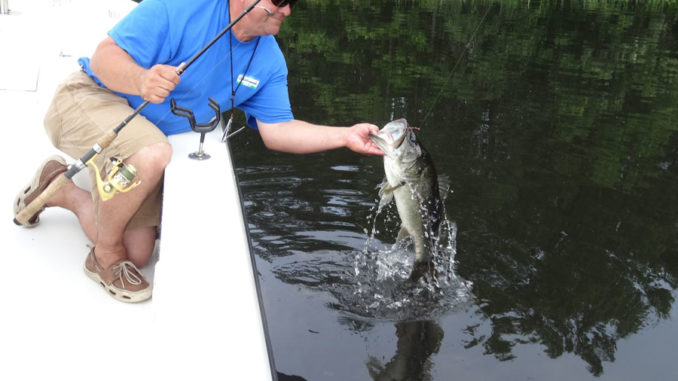
Grass, pads, trees all hold shallow bass for Lake Moultrie anglers.
When Cecil Wolfe cranked the outboard, the fisherman with him burrowed into the seat of the big bass rig, ready for a fast ride through the cypress trees around the perimeter of Lake Moultrie. But Wolfe idled slowly only a few hundred yards, shut the big motor down in shallow water next to some heavy cover, dropped the trolling motor and said it was time to fish.
Talk about an August surprise.
Strategies for catching largemouth bass are as varied as the fishermen, and that’s particularly true on Lake Moultrie during hot weather. While the huge, open body of water is full of drops, humps and ledges that hold during the summer, it’s also ringed with plenty of shallow, bass-holding cover.
In recent years, with the resurgence in natural vegetative cover, fishermen have learned that the shallow water is very productive in the summer, just as it is during the spring. According to Wolfe and other experts, the key to success is keeping your options open.
Wolfe said that years ago, when fishermen targeted bass in the summer’s heat, open-water drops and ledges were keys to success. Now that has changed substantially.
“The key now for summertime bass action is the heavy, natural, vegetative cover in the shallow water,” Wolfe said. “While some fish can be caught on the open-water drops, most fishermen in the know relate to the shallow cover. These fish are found deeper than in the spring and often orient to small drops: slightly deeper holes, ditches or depressions that have a lot of cover in or around them. But the resurgence of the native vegetation has kept the bass more prone to hold in shallow water, even in the heat of August.
“The key is to work the shallow cover in the 4- to 7-foot depth range,” Wolfe said. “The early morning and late evening low-light fishing using topwater lures is often very effective, even during August. However, once the sun gets up, accurate casts to heavy cover targets are usually a major key to success.
The 48-year-old Wolfe, who guides out of Blacks Camp, said Lake Moultrie is very productive during August, but anglers sometimes have to spend a little time working out patterns.
Kevin Davis, 43, who is co-owner and guides out of Blacks Camp, has a special fondness for summertime bass fishing.
“Summertime largemouth fishing can be a thinking game as well as just covering a lot of territory,” Davis said. “During spring, success is often measured at the end of the day by how many casts you make to shallow cover. During August, making more casts is a positive thing; it is paramount to success that fishermen make casts to just the right places. Bass can be much more specific in what cover they prefer.
“The entire summer is excellent fishing, but during August, the fishing and the weather create unique situations that anglers must understand. Good examples of places to find quality and quantity fish will be in the shallow edges along creek channels or ditches, even if the channels are only slightly deeper than the surrounding water. Also, depressions with vegetative or tree cover in the 3- to 7-foot depth range are good.
“Some fishermen think that the big-fish season is over, but that’s certainly not the case. Summertime fishing will produce a lot of heavy largemouth, just not as many as during the spring. Fishermen may not get as many big-fish bites, but they can still hook some quality fish. It’s very realistic to have the opportunity to hook into a 7- to 8-pound largemouth. Fishermen just have to keep moving and searching until they locate a spot with big fish, then work that area hard.”
In August, Davis said he will use a variety of lures, including worms, topwaters and soft-plastic, frog-type baits as well as shallow-running crankbaits and a variety of bottom-bumping lures, depending on where he is fishing.
“During the past couple of years, we’ve caught a lot of quality largemouth out of the eel grass in Lake Moultrie,” Davis said, “but the key is to stay on the move until you figure the pattern for the day.”
One of Davis’s favorite August patterns is to work specific areas where multiple types of vegetation come together.
“When I find two or more types of vegetation that come together, I think it’s similar to the ‘edge effect’ for wildlife, and it seems to draw the bass to it,” he said. “Not only does the top of the water offer a more complex situation and cover, but you know that something is different beneath the water where the bass are. The combining of the different roots of the two types of vegetation are an attractant as well as perhaps a subtle change in bottom substrate or depth. All these combine to make an appealing place for a bass to hang out in hot weather.”
“One favorite shallow-water area is the big shallow area near Blacks Camp Cove, as well as the Hatchery near Moncks Corner,” he said. “These areas have a great deal of shallow cover but there’s also some slightly deeper water. During August, I suggest fishermen stay close to the deeper water. Most of the bass will be close to that deeper water, holding on trees or other woody or vegetative cover.
“When the conditions are right in terms of depth, proximity to deeper water and forage being present, you’ll often find more than one good bass in a specific area. Catching a couple of quality fish pretty quick is a real possibility. Also, anywhere you see isolated clumps of weed or grass cover is a good August target.
“As always, find the forage, and you can find the fish,” Davis said. “I’ve found that where the forage goes, so do the largemouth. ‘Match the hatch’ is a good recommendation for lures, because when I can see what the bass are feeding on, I try to match it in size and color of lure, and it often makes a big difference.”
Davis said the Russellville Flats are another shallow-water hotspot he recommends during the summer.
“This area gets considerable pressure during the spring, but by August, not as many bass fishermen are back in there,” he said. “I key on the areas of slightly deeper water, such as old, inundated pockets of slightly deeper water — and the blackwater ponds are key areas. Even a few inches change in depth can be significant at this time of year in shallow water.”
During hot weather, Wolfe said he will focus on the outside woody cover wherever he is fishing Lake Moultrie.
“If I’m fishing around cypress trees, I’ve found that I’ll catch far more fish at this time of the year on the point trees nearest the deeper water,” Wolfe said. “I’ll fish back in the trees a little way, but not far unless I’m getting consistent action.”
While shallow-water fishing has enjoyed a resurgence due to the shallow vegetation, fish still live on the open-water drops.
“Bass fishing during the summer was once viewed as an open-water fishery on Lake Moultrie,” Davis said. “While the shallow-water fishing has improved tremendously with the native vegetation, the open water is still an effective technique — it’s just not the only or best summertime pattern.
“The mid-lake areas have actually become more difficult to fish, unless you know the precise location of underwater woody cover. There is brush and cover along some of those humps and ledges that will attract and hold bass, but a lot of these areas are small, precise targets, and unless you have the exact coordinates of those structures on a GPS, they can be difficult to find. But if you know the location of those types of places, the open-water areas still provide excellent fishing.”
Wolfe and Davis both said the key to success is to keep your options open and let diversity rule.
“Don’t get locked into any single frame of mindset as to where bass will be during hot weather,” Wolfe said. “Some will be shallow, some deeper on drops and some in between. Heavy cover, the Diversion Canal and open water will all produce based on the specific conditions. Overall, Lake Moultrie presents a great and diverse opportunity for productive August bass fishing.”
DESTINATION INFORMATION
HOW TO GET THERE/WHEN TO GO — Moncks Corner is an ideal jumping-off spot near Lake Moultrie, off I-26 and US 52 just north of Charleston. The town of Santee also offers good access to the Diversion Canal and Lake Moultrie from I-95 at Exit 98. August is a great month for both quantity and quality bass, with surprisingly good shallow-water action. In addition, those with good maps or knowledge of drops with woody cover can do well fishing the mid-lake humps and drops and ledges.
BEST TECHNIQUES — Diversity is your best fishing friend. A variety of lures, including soft plastics fished in the shallow water, often rule the day. However, fishermen can also work the Diversion Canal as well as drops and ledges where cover exists. But shallow water is now an important part of the fishing equation. Anglers can begin the day with topwater lures, then work slightly deeper water and heavy cover. In addition, using crankbaits on shallow humps, points and the offshore drops with woody cover can be outstanding. It’s best to key on areas with forage fish in the area for best results, regardless of where you fish.
FISHING INFO/GUIDES — Cecil Wolfe, Linwood Thornhill and Kevin Davis all guide out of Blacks Camp, 843-753-2231 or www.blackscamp.com. See also Guides and Charters in Classifieds.
ACCOMMODATIONS — Blacks Camp, 843-753-2231 or www.blackscamp.com; Santee Cooper Country, 803-854-2131 or www.santeecoopercountry.org; Berkeley County Chamber of Commerce, Moncks Corner, 800-882-0337.
MAPS — Fishing Hotspots, 800-338-5957; DeLorme’s. South Carolina Atlas & Gazetteer, 207-846-7000 or http://www.delorme.com/.

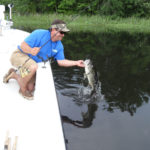
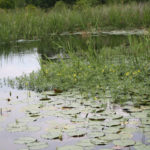
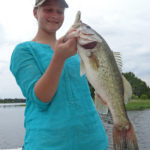
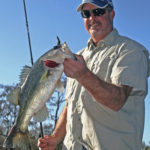
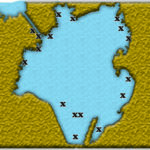




Be the first to comment